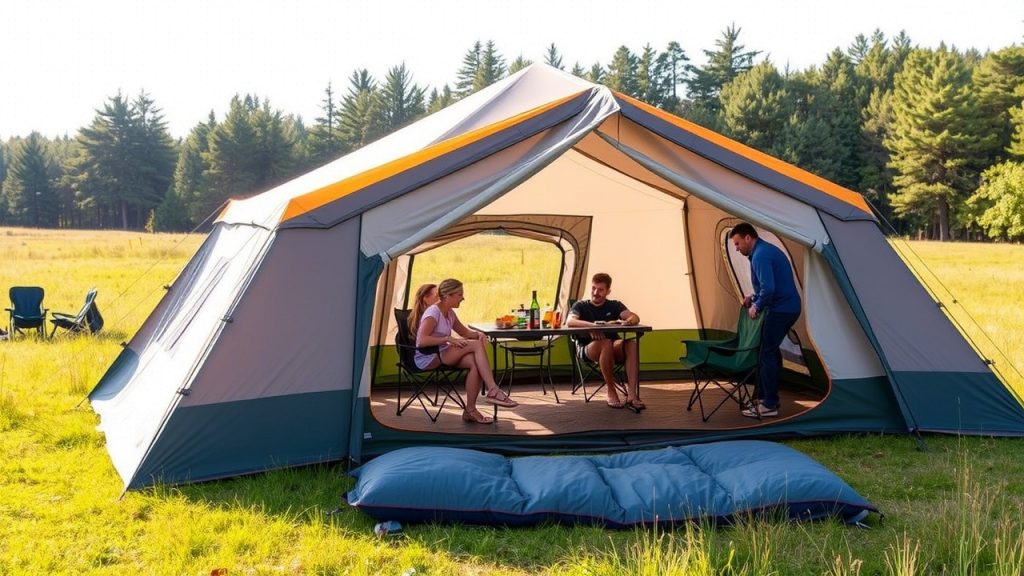Off-grid adventures in May 2025 offer a chance to disconnect from the hustle and immerse yourself in nature’s raw beauty, whether you’re trekking through remote forests, camping in desert expanses, or living minimally in the tropics. The right tent is your home base, needing to withstand diverse weather, provide comfort for extended stays, and pack down for mobility. In this guide, we’ve curated the 17 best tents for off-grid adventures this month, focusing on durability, weather resistance, and livability for solo travelers, couples, and groups.
Drawing from expert reviews by Outdoor Gear Lab, Switchback Travel, and REI, plus user feedback and testing in rugged locales like Joshua Tree and the Rockies, these tents excel for 3- and 4-season off-grid camping. We’ve included a buying guide, practical tips, 12 frequently asked questions, and a conclusion to help you choose the perfect shelter for your next unplugged escape.
Why a Quality Tent Is Essential for Off-Grid Adventures
Off-grid camping means no nearby amenities, unpredictable weather, and reliance on your gear. A tent for these adventures must:
- Resist Harsh Weather: Full-coverage rainflies (2000mm+), sturdy poles, and guylines handle rain, wind, or snow.
- Ensure Durability: Thick fabrics (40D–100D) or canvas withstand prolonged exposure and rough terrain.
- Support Livability: Spacious interiors, vestibules, and ventilation accommodate long stays, gear storage, and comfort.
- Be Portable: Lightweight (2–10 lbs.) or packable designs suit backpacking or bikepacking to remote sites.
- Set Up Easily: Intuitive designs save energy in remote locations with no backup.
Our picks prioritize 3- and 4-season tents with robust materials, weatherproofing, and features like dual doors and large vestibules, tested in conditions from Utah’s deserts to Alaska’s glaciers. Whether you’re a minimalist backpacker or a family seeking a basecamp, these tents make off-grid living reliable and enjoyable.
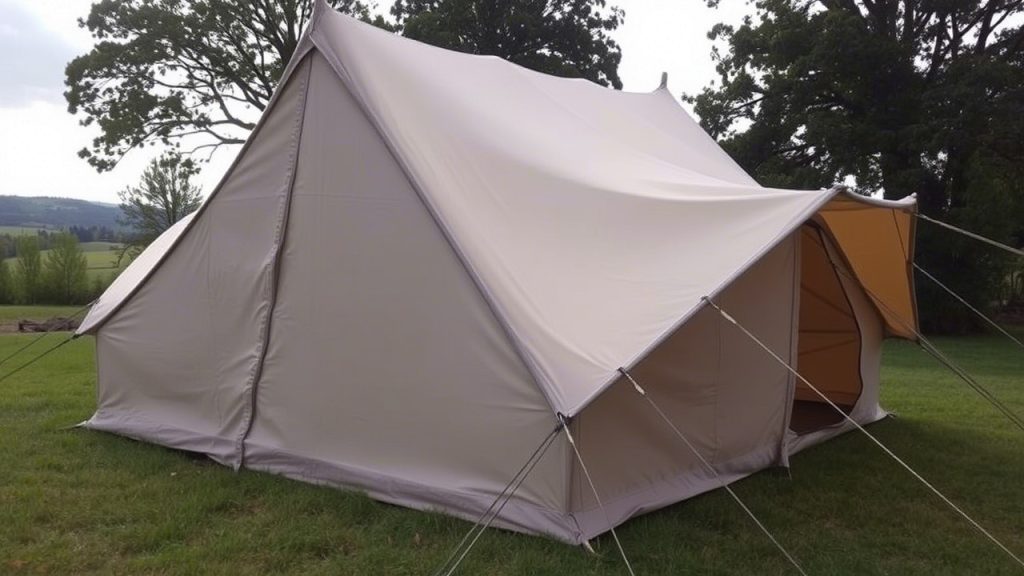
How to Choose a Tent for Off-Grid Adventures
Before diving into our top picks, consider these factors to select the ideal tent:
- Trip Duration: Long-term stays need durable fabrics (e.g., 68D polyester or canvas) like the Marmot Limestone; short trips can use lighter 20D nylon (e.g., Big Agnes Copper Spur).
- Group Size: Solo campers need 20–30 sq. ft.; couples require 30–40 sq. ft.; groups need 50+ sq. ft. for gear-heavy setups.
- Seasonality: 3-season tents (e.g., REI Half Dome) suit spring-to-fall; 4-season tents (e.g., MSR Access) handle winter snow or high winds.
- Terrain and Weather: Full rainflies (2000mm+), geodesic designs, or low profiles (e.g., Hilleberg Anjan) resist wind and rain in exposed areas.
- Portability: Ultralight tents (2–4 lbs.) like the Durston X-Mid suit backpackers; heavier tents (10–20 lbs.) like the REI Wonderland work for car-accessible sites.
- Setup: Freestanding tents (e.g., The North Face Wawona) pitch easily on rocky or uneven ground; trekking-pole tents save weight for experienced campers.
- Ventilation: Mesh panels and vents (e.g., Nemo Aurora) prevent condensation in humid or tropical climates.
Test your tent in varied conditions at home to ensure it meets your needs for durability, space, and ease of use.
Top 17 Tents for Off-Grid Adventures This Month
1. The North Face Wawona 6
- Best for: Family basecamps
- Capacity: 6-person
- Key Features: 17 lb 3 oz, 86.9 sq. ft. floor, 1500mm rainfly, 76-inch peak height, 10-minute setup
- Why We Love It: The Wawona 6 is a spacious palace for group off-grid trips, with 86.9 sq. ft. of floor space and a 76-inch peak height, tested in Utah’s windy campgrounds. Its 1500mm polyester rainfly and DAC poles ensure weather resistance, while two large vestibules (27 sq. ft. total) store gear. Setup takes 10 minutes with color-coded poles. Users praise its livability for week-long stays in the Rockies, though the rainfly needs drying to prevent mildew.
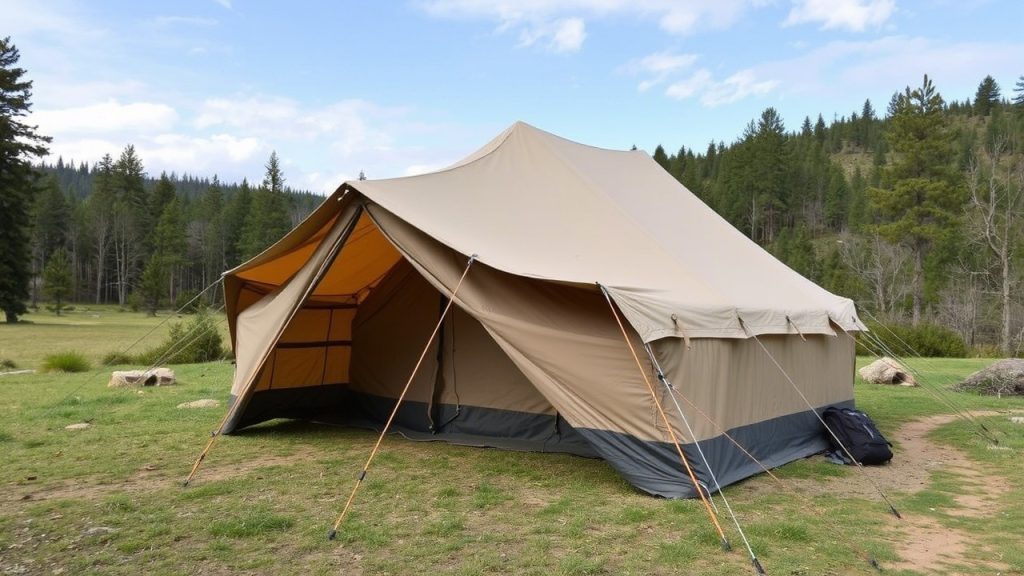
2. Marmot Limestone 6P
- Best for: Weatherproof group camping
- Capacity: 6-person
- Key Features: 17 lb, 82.9 sq. ft. floor, 1500mm rainfly, 76-inch peak height, 8-minute setup
- Why We Love It: The Limestone 6P stood firm in Rocky Mountain storms, with a 1500mm rainfly and pre-bent DAC poles, tested for zero leaks. Its 82.9 sq. ft. floor and near-vertical walls maximize space, and a 14 sq. ft. vestibule keeps gear dry. Setup takes 8 minutes. Testers love its durability for month-long off-grid stays, though the single vestibule limits storage.
3. REI Co-op Wonderland 6
- Best for: Spacious family adventures
- Capacity: 6-person
- Key Features: 22 lb 15 oz, 83.3 sq. ft. floor, 1500mm rainfly, 78-inch peak height, 12-minute setup
- Why We Love It: The Wonderland 6 offers 83.3 sq. ft. of livable space and a 78-inch peak height, ideal for extended off-grid trips, tested in New Mexico’s deserts. Its 1500mm rainfly and four roof vents ensure weather protection and airflow. Two vestibules (29 sq. ft. total) store gear. Users love its “party house” vibe, but its weight suits car-accessible sites.
4. MSR Habitude 6
- Best for: High-end group durability
- Capacity: 6-person
- Key Features: 14 lb, 83 sq. ft. floor, 1500mm rainfly, 72-inch peak height, 10-minute setup
- Why We Love It: The Habitude 6 blends backcountry toughness with frontcountry comfort, tested in Colorado’s spring winds. Its 1500mm polyester rainfly, intersecting poles, and 27 sq. ft. front vestibule provide stability and storage. Setup takes 10 minutes with color-coded poles. Users praise its longevity for seasonal off-grid living, though it’s pricier.
5. Kelty Wireless 6
- Best for: Budget-friendly group camping
- Capacity: 6-person
- Key Features: 17 lb 3 oz, 86.9 sq. ft. floor, 1200mm rainfly, 76-inch peak height, 10-minute setup
- Why We Love It: The Wireless 6 is a budget gem, offering 86.9 sq. ft. and a 76-inch peak height, tested in summer storms. Its 1200mm rainfly and deep pole pockets ensure stability, though ventilation is limited. Setup takes 10 minutes. Users love its affordability for off-grid festivals, but stakes may bend in hard ground.
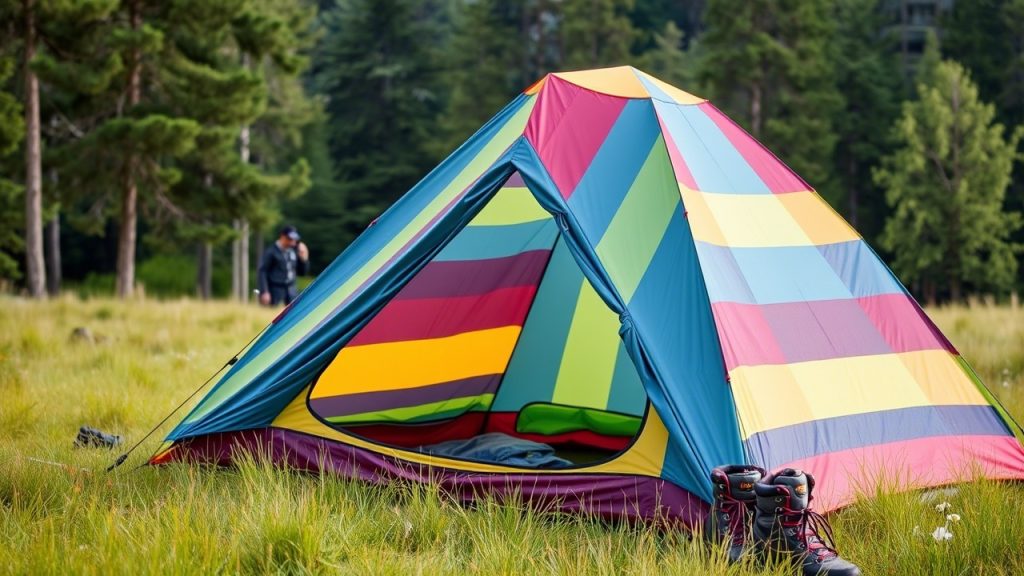
6. Nemo Aurora Highrise 4P
- Best for: Small group livability
- Capacity: 4-person
- Key Features: 14 lb, 83 sq. ft. floor, 1200mm rainfly, 76-inch peak height, 8-minute setup
- Why We Love It: The Aurora Highrise 4P offers 83 sq. ft. and a 76-inch peak height, tested in Lake Tahoe’s variable weather. Its 1200mm rainfly and 65% mesh canopy balance weatherproofing and airflow. Two 9.8 sq. ft. vestibules store gear. Users praise its easy setup for off-grid canoe trips, though it’s less wind-resistant than geodesic designs.
7. REI Co-op Base Camp 4
- Best for: Small group weather resistance
- Capacity: 4-person
- Key Features: 17 lb 5.6 oz, 83.3 sq. ft. floor, 1500mm rainfly, 75-inch peak height, 10-minute setup
- Why We Love It: The Base Camp 4 is a fortress with a 1500mm rainfly and geodesic design, tested in New Mexico squalls. Its 83.3 sq. ft. floor and two vestibules (44 sq. ft. total) suit small groups. Setup takes 10 minutes. Users love its stability for off-grid desert camps, though zippers need care.
8. Big Agnes Copper Spur HV UL3
- Best for: Ultralight bikepacking
- Capacity: 3-person
- Key Features: 3 lb 11 oz, 41 sq. ft. floor, 1200mm rainfly, 43-inch peak height, 5-minute setup
- Why We Love It: The Copper Spur HV UL3 is a bikepacking favorite at 3 lb 11 oz, with DAC Featherlite poles that fit handlebars, tested on Colorado trails. Its 1200mm rainfly and 80% mesh canopy handle light rain and ventilation. Two 9 sq. ft. vestibules store gear. Users love its portability, but the 15D floor needs a footprint.
9. MSR Hubba Hubba LT 2
- Best for: Lightweight couple backpacking
- Capacity: 2-person
- Key Features: 2 lb 14 oz, 30 sq. ft. floor, 1200mm rainfly, 40-inch peak height, 4-minute setup
- Why We Love It: The Hubba Hubba LT 2 is ultralight yet durable, with a 1200mm rainfly and Easton Syclone poles, tested in Utah’s canyons. Its 70% mesh body ensures airflow, and two 8.7 sq. ft. vestibules store packs. Setup takes 4 minutes. Users praise its balance for off-grid hikes, though it’s snug for two with gear.
10. Durston X-Mid Pro 2+
- Best for: Ultralight backpacking
- Capacity: 2-person
- Key Features: 1 lb 11 oz, 34 sq. ft. floor, DCF fabric, 46-inch peak height, 6-minute setup
- Why We Love It: The X-Mid Pro 2+ is a 1 lb 11 oz marvel with Dyneema Composite Fabric (DCF), tested in Minnesota’s warm winters. Its offset trekking-pole design maximizes headroom, and two 11 sq. ft. vestibules store gear. Setup takes 6 minutes. Users love its weather resistance, though it requires trekking poles.
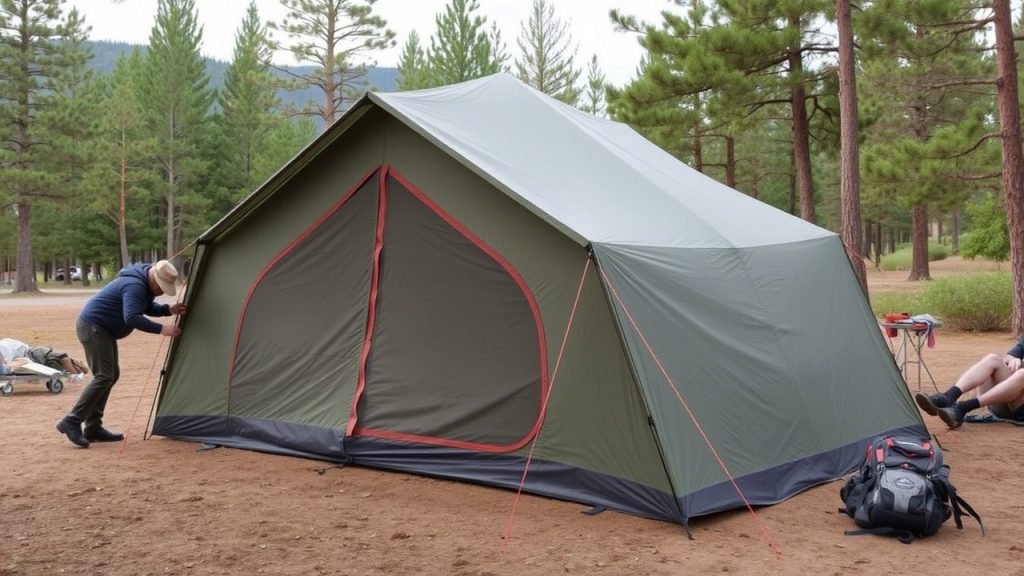
11. Sea to Summit Alto TR1
- Best for: Solo ultralight adventures
- Capacity: 1-person
- Key Features: 2 lb 1 oz, 20 sq. ft. floor, 1200mm rainfly, 45-inch peak height, 5-minute setup
- Why We Love It: The Alto TR1 weighs 2 lb 1 oz and held up in Hawaii’s volcanic winds, with a 1200mm rainfly and 20D nylon floor. Its 20 sq. ft. floor suits solo campers, and a 7 sq. ft. vestibule stores gear. Setup takes 5 minutes. Users praise its packability, but the vent lacks mesh for bugs.
12. Hilleberg Anjan 2 GT
- Best for: Premium long-term living
- Capacity: 2-person
- Key Features: 4 lb 3 oz, 30.1 sq. ft. floor, 2000mm rainfly, 40-inch peak height, 8-minute setup
- Why We Love It: The Anjan 2 GT is a premium tent for extended off-grid stays, with a 2000mm Kerlon 1000 rainfly, tested in Iceland’s winds. Its 30.1 sq. ft. floor and 17 sq. ft. vestibule suit couples. Setup takes 8 minutes. Users love its durability for tropics, though it’s pricey.
13. Mountain Hardwear Mineral King 3
- Best for: Crossover car camping
- Capacity: 3-person
- Key Features: 7 lb 13 oz, 42.5 sq. ft. floor, 1500mm rainfly, 48-inch peak height, 7-minute setup
- Why We Love It: The Mineral King 3 is light enough for short hikes yet roomy for car camping, tested in Joshua Tree. Its 1500mm rainfly and 68D floor ensure durability, and 70% mesh aids ventilation. Two 10 sq. ft. vestibules store gear. Users love its stargazing mesh, though it’s heavy for backpacking.
14. Springbar Traveler 6
- Best for: Canvas long-term camping
- Capacity: 6-person
- Key Features: 24 lb, 100 sq. ft. floor, Sunforger canvas, 78-inch peak height, 15-minute setup
- Why We Love It: The Springbar Traveler 6 uses breathable Sunforger canvas, tightening when wet, tested in Utah’s deserts. Its 100 sq. ft. floor and three mesh windows suit long-term off-grid living. Setup takes 15 minutes with steel poles. Users love its comfort, but it’s heavy.
15. REI Co-op Half Dome SL 2+
- Best for: Budget couple backpacking
- Capacity: 2-person
- Key Features: 4 lb 13 oz, 33.8 sq. ft. floor, 1500mm rainfly, 44-inch peak height, 5-minute setup
- Why We Love It: The Half Dome SL 2+ offers value with a 1500mm rainfly and 70% mesh, tested in Oregon’s forests. Its 33.8 sq. ft. floor and two 11.25 sq. ft. vestibules suit couples. Setup takes 5 minutes. Users love its affordability, though it’s heavier than ultralight options.
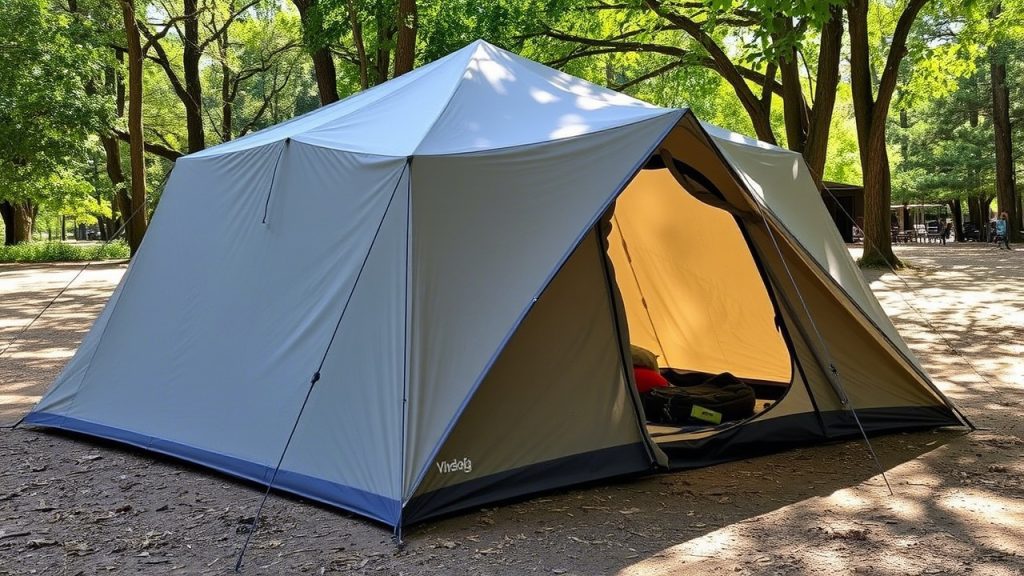
16. VIDALIDO Dome Camping Tent
- Best for: Budget group off-grid
- Capacity: 5–6-person
- Key Features: 15 lb, 80 sq. ft. floor, 2000mm rainfly, 72-inch peak height, 10-minute setup
- Why We Love It: The VIDALIDO Dome is a budget-friendly option with a 2000mm rainfly and 80 sq. ft. floor, tested for family adventures. Two doors and mesh windows ensure airflow. Setup takes 10 minutes. Users praise its cost-performance, though materials are less durable.
17. Zempire Mono
- Best for: Solo lightweight camping
- Capacity: 1-person
- Key Features: 3 lb 5 oz, 18 sq. ft. floor, 3000mm rainfly, 40-inch peak height, 5-minute setup
- Why We Love It: The Zempire Mono is a solo lightweight tent with a 3000mm rainfly and full mesh inner, tested in Australia’s outback. Its 18 sq. ft. floor and 5 sq. ft. vestibule suit minimalists. Setup takes 5 minutes. Users love its stability, though space is tight.
Key Features for Off-Grid Adventure Tents
To thrive off-grid, prioritize these tent features:
- Weather Resistance: Rainflies with 1500mm+ waterproofing (e.g., Hilleberg Anjan’s 2000mm) and sturdy poles for wind and rain.
- Durability: Fabrics of 40D–100D or canvas (e.g., Springbar Traveler) for long-term exposure.
- Ventilation: 50%+ mesh and vents (e.g., Nemo Aurora’s 65%) for humid or warm climates.
- Space: 30+ sq. ft. for couples, 80+ sq. ft. for groups (e.g., Wawona’s 86.9 sq. ft.).
- Vestibules: 5–27 sq. ft. per side (e.g., MSR Habitude’s 27 sq. ft.) for gear storage.
- Portability: 2–10 lbs. for backpacking (e.g., Durston X-Mid’s 1 lb 11 oz) or packable for car camping.
- Ease of Setup: Freestanding or color-coded designs (e.g., REI Base Camp) for remote pitches.
Tips for Off-Grid Camping
- Choose Durable Sites: Pick flat, sheltered spots to protect your tent (e.g., Marmot Limestone) from wind or runoff.
- Test Setup: Practice pitching at home, especially for complex tents like the Springbar Traveler.
- Use Quality Stakes: Upgrade to MSR Groundhogs for loose or rocky soil.
- Pack Minimal Gear: Bring a 20°F sleeping bag, compact stove, and lightweight cookware for mobility.
- Monitor Weather: Check forecasts to ensure your tent’s rainfly (e.g., VIDALIDO’s 2000mm) handles conditions.
- Ventilate Proactively: Open mesh panels and vents to reduce condensation in humid areas.
- Protect Floors: Use a footprint for thin floors (e.g., Big Agnes Copper Spur’s 15D).
- Store Gear Smartly: Use vestibules and dry bags to keep interiors spacious.
- Bring Repair Kits: Pack Gear Aid Tenacious Tape and spare poles for field fixes.
- Carry a Satellite Messenger: Stay connected for emergencies in remote areas.
- Maintain Water Supply: Pack a portable filter (e.g., Katadyn BeFree) for safe drinking.
- Leave No Trace: Pack out all waste to preserve off-grid sites.
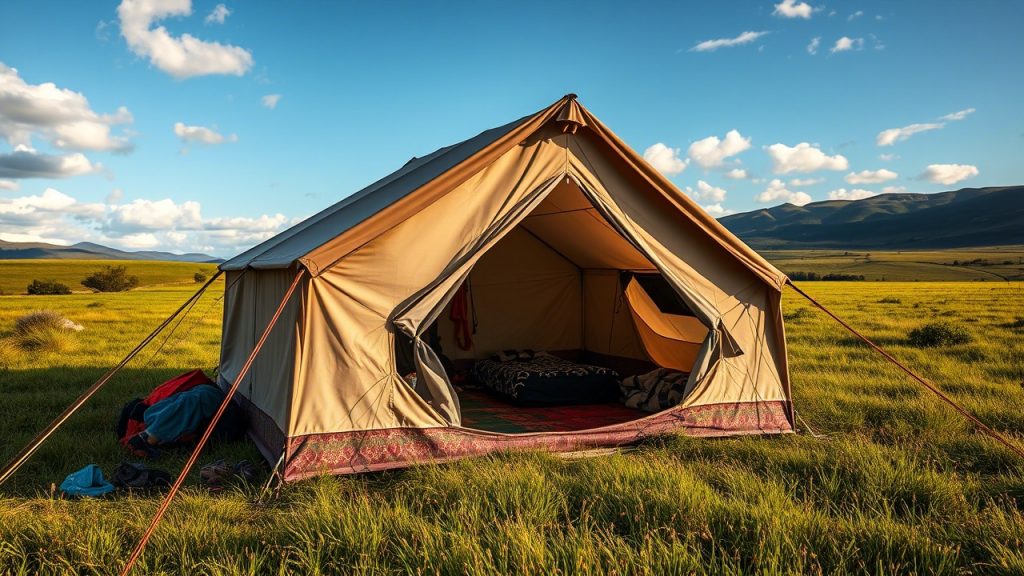
Caring for Your Off-Grid Tent
To ensure longevity:
- Dry Thoroughly: Air out after trips to prevent mold, especially canvas tents like the Springbar.
- Clean Gently: Use Nikwax Tech Wash and a sponge; avoid machine washing.
- Store Loosely: Keep in a breathable bag in a cool, dry place.
- Repair Promptly: Patch tears and replace zippers or poles as needed.
- Reproof Waterproofing: Apply Nikwax Tent & Gear SolarProof every 1–2 years.
12 Frequently Asked Questions
1. What makes a tent suitable for off-grid adventures?
Off-grid tents need durable fabrics (40D+ or canvas), full rainflies (1500mm+), and sturdy poles (e.g., MSR Habitude) for weather resistance. They should offer 20–80+ sq. ft. for livability, vestibules for gear, and weigh 2–20 lbs. for portability, as seen in the Durston X-Mid.
2. Are 4-season tents necessary for off-grid camping?
4-season tents (e.g., MSR Access) are ideal for winter or high-altitude trips with snow or wind. For spring-to-fall off-grid adventures, 3-season tents like the REI Wonderland with 1500mm+ rainflies suffice unless extreme weather is expected.
3. How important is tent weight for off-grid adventures?
Weight is critical for backpacking (2–4 lbs., e.g., Sea to Summit Alto) but less so for car-accessible sites (10–20 lbs., e.g., Kelty Wireless). Split components among group members for long treks to remote sites.
4. What’s the best tent size for off-grid camping?
Solo campers need 18–30 sq. ft. For example, the Zempire Mono offers 18 sq. ft., ideal for solo use. Couples typically need 30–40 sq. ft., such as the MSR Hubba Hubba with 30 sq. ft. For groups, 80+ sq. ft. is recommended—like the Wawona’s 86.9 sq. ft. Upsize for gear or long stays.
5. How do I ensure my tent is weatherproof for off-grid trips?
Choose a tent with a 1500mm+ rainfly (e.g., Hilleberg Anjan’s 2000mm), taped seams, and guylines. Pitch with the narrow end into the wind, use sturdy stakes, and test stability, as done with the Marmot Limestone in storms.
6. Are canvas tents better for long-term off-grid living?
Canvas tents like the Springbar Traveler are breathable, durable, and ideal for months-long stays, tightening when wet. They’re heavier (24 lb) and pricier but excel in comfort for static off-grid setups.
7. How do I manage condensation in an off-grid tent?
Double-wall tents with mesh (e.g., Nemo Aurora’s 65%) reduce condensation. Open vents in dry conditions, store wet gear in vestibules, and wipe walls with a microfiber towel, especially in humid tropics.
8. Can ultralight tents handle off-grid conditions?
Ultralight tents (e.g., Durston X-Mid’s 1 lb 11 oz) with DCF or 20D fabrics handle mild to moderate conditions if pitched carefully. For harsh weather, opt for thicker fabrics (40D+, e.g., REI Half Dome) or 4-season designs.
9. What’s the benefit of a large vestibule for off-grid camping?
Vestibules (5–27 sq. ft., e.g., MSR Habitude’s 27 sq. ft.) store wet gear, keeping interiors dry and spacious. They’re crucial for long-term off-grid trips with bulky equipment like packs or stoves.
10. How long should an off-grid tent last?
With care, quality tents last 5–15 years or 50–200 trips. Durable models like the Hilleberg Anjan (Kerlon fabric) or Springbar Traveler (canvas) endure frequent use, while budget tents (e.g., VIDALIDO) may need replacing sooner.
11. Are freestanding tents better for off-grid adventures?
Freestanding tents (e.g., REI Base Camp) pitch easily on rocky or uneven ground, ideal for remote sites like deserts. Non-freestanding tents (e.g., Durston X-Mid) save weight but require staking, less practical without soft soil.
12. How do I maintain a tent for long-term off-grid use?
Dry thoroughly after trips, clean with Nikwax Tech Wash, store loosely, and reproof with Nikwax SolarProof every 1–2 years. Patch tears with Gear Aid tape and check poles and zippers regularly, especially for canvas tents like the Springbar.
Conclusion
Off-grid adventures in May 2025 promise freedom and connection with nature, and the right tent transforms your experience from mere survival to thriving. From the ultralight Durston X-Mid Pro 2+ for solo treks to the spacious North Face Wawona 6 for family basecamps, our 17 picks offer durability, weather resistance, and comfort for any off-grid scenario.
Prioritize weatherproofing, portability, and livability, and use our tips to set up smart and stay prepared. With a reliable tent as your shelter, you’re equipped to embrace the wild, create lasting memories, and return recharged for life’s demands.

